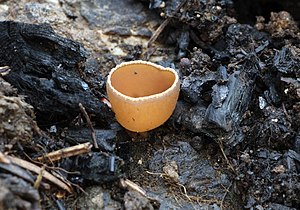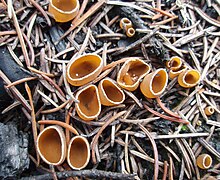Common coal mug
| Common coal mug | ||||||||||||
|---|---|---|---|---|---|---|---|---|---|---|---|---|

Common coal mug ( Geopyxis carbonaria ) |
||||||||||||
| Systematics | ||||||||||||
|
||||||||||||
| Scientific name | ||||||||||||
| Geopyxis carbonaria | ||||||||||||
| ( Alb. & Pig. ) Sacc. |
The common coal cupling ( Geopyxis carbonaria ) is a largely saprobiontic type of fungus on burn sites from the family of fire pillow relatives (Pyronemataceae).
features
Macroscopic features
The common coal cup forms cup-shaped apothecia , which are initially light red to orange, in later age yellow-brown to brown. They are usually formed in groups or tufts and reach a diameter of 5 to 15 mm. The edge is clearly lighter pale yellow and serrated flaky. The light brown outside of the fruiting bodies is smooth.
Microscopic features
The club-shaped tubes are 180 to 250 × 10 to 11 µm in size and each contain eight ascospores . The spores themselves are hyaline , ellipsoidal, smooth, have no oil droplets and are 13 to 15 × 6 to 8 μm in size. The paraphyses are narrow, septate and forked at the base, their tips are not elongated.
Species delimitation
The common coal cup may be confused with other yellow-orange colored cups , but especially with other, but rarer, generic representatives. It is particularly similar to Geopyxis vulcanalis , which has deep-edged cups that are flattened with age. It grows in coniferous forests, between mosses. A clear indicator is its odor of sulfur when crushed.
ecology
The common coal cup appears from spring to autumn and has a remarkable ecology: it occurs particularly on fire sites, on forest fire areas it sometimes occurs in large numbers. It is involved in the breakdown of conifer roots and litter after fires and is able to break down lignin. However, the coal cup can also form a mycorrhiza with trees, at least with the spruce .
distribution
The common coal cup has a very wide distribution in Europe from Spain to northern Scandinavia. In North America it occurs from Alaska to California and Quebe. The species also occurs in Asia (Japan, Tajikistan, Russia) and even Australia. It is quite common in Central Europe, and sometimes massive on forest fire areas.
Systematics
The common coal cup was first described in 1805 by Johannes Baptista von Albertini and Lewis David von Schweinitz as Peziza carbonaria . Pier Andrea Saccardo described the species in 1889 under the current name Geopyxis carbonaria .
literature
- Svengunnar Ryman, Ingmar Holmåsen: Mushrooms. Over 1,500 species of mushrooms are described in detail and photographed in their natural surroundings . Bernhard Thalacker, Braunschweig 1992, ISBN 3-87815-043-1 , p. 630 .
Individual evidence
- ↑ a b c d e Svengunnar Ryman, Ingmar Holmåsen: Mushrooms. Over 1,500 species of mushrooms are described in detail and photographed in their natural surroundings . Bernhard Thalacker, Braunschweig 1992, ISBN 3-87815-043-1 , p. 630 .
- ↑ a b c Michael Beug, Alan E. Bessette, Arleen R. Bessette: Ascomycete Fungi of North America: A Mushroom Reference Guide . University of Texas Press, 2014, ISBN 978-0-292-75452-2 ( Online - 502 pages).
- ↑ Trude Vrålstad, Arne Holst-Jensen, Trond Schumacher: The postfire discomycete Geopyxis carbonaria (Ascomycota) is a biotrophic root associate with Norway spruce ( Picea abies ) in nature . In: Molecular Ecology . tape 7 , no. 5 , 1998, pp. 609–616 , doi : 10.1046 / j.1365-294x.1998.00365.x ( online , PDF).
- ↑ Geopyxis carbonaria (Alb & pig..) Sacc, 1889 -. Checklist View. In: GBIF Portal . Retrieved May 11, 2016 .
- ↑ Geopyxis carbonaria . In: MycoBank . Retrieved May 11, 2016 .
